The immense scale of being. Part 1. Interplanetary gave

Since ancient times, man has tried to understand the structure of the world around him and find his place in it. For thousands of years, the persistence and ingenuity of his mind have brought a person closer to an objective understanding of the world despite the subjective (not seldom false) perception fixed by culture. One of the first tasks to achieve these goals is to determine the scale of the world around us.
In this review, I will acquaint you with the history of human comprehension of the scale of the universe from the era of inventive Greeks to the modern era of high technologies. You will find out why the “flat Earth on three whales” caused laughter from the ancient Romans, how contemporaries of the Sun King determined interplanetary distances and how cosmic cataclysms help comprehend the universal scale.
The scale of the Greek genius
Ancient Greek thinkers were among the first to go on an intellectual assault on the mysteries of the scale of our world. One of the greatest ancient astronomers Aristarchus of Samos (4-3 century BC) stands apart among them. He decided to calculate the relative distances between the Earth, the Sun and the Moon, using a rather developed geometric apparatus of his time.
')
Aristarchus correctly assumed that the moon was in the shape of a sphere and receives light from the sun. Consequently, in the half-month phase, the rays of the Sun fell on the Moon exactly perpendicular to the line of sight of the earth observer. Thus, by measuring the angular distance between the centers of the Moon and the Sun in the sky of the Earth, it was possible to calculate the relative distances using the principles of the geometry of a triangle. The measured angle was 87, on the basis of which Aristarchus calculated that the Sun is 19 times farther from the Earth than the Moon. Knowing that the angular dimensions of the Sun and the Moon in the sky coincide (solar eclipses testified to this), Aristarchus decided that the Sun was 20 times the size of the Moon.
Such a 20-fold error regarding the real state of affairs is explained by the fact that without exact astronomical instruments it is extremely difficult to determine the exact moment of quadrature (half a month). However, progress was on the face, given the fact that many astronomers of his time believed that the sun could measure with a large Greek polis.
The tangent of an angle of 87 °, as already shown, was 19.08, the tangent of an angle of 89 ° was slightly more than 57, and the tangent of the true quadrature of ~ 89.85 ° is already close to 400. i.e. This method is very demanding on the accuracy of determining the angle alpha.
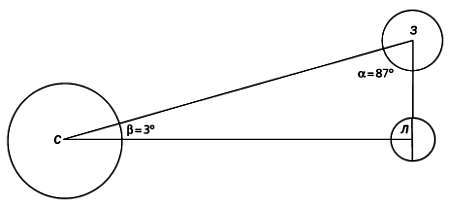
The scientist went further, deciding to establish the relative sizes of the Moon and the Earth using already lunar eclipses. Once again, correctly deciding that the Moon is eclipsed by the Earth’s shadow, and the angular size of the shadow on the Moon’s orbit is twice as large as the last, Aristarchus concludes that the Earth’s radius (taken as a conventional unit) is 3 times the lunar radius (current estimate of 3.6). In this case, it turned out that the radius of the Sun is more than 6 times larger than that of the Earth (a modern estimate is 109 times).
Ancient Greek scheme for calculating the distance to the moon and its size
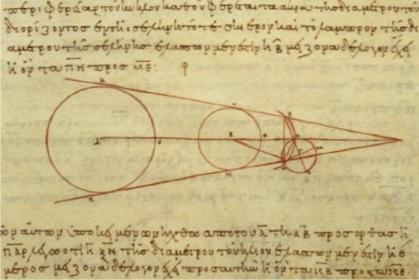
Apparently the enormous size of the Sun, for the first time in history, suggested to Aristarchus that it was the Earth that revolves around a star, and not vice versa, as it was then believed. On the objection about why in this case the sphere of stars does not change its position relative to the celestial sphere due to the motion of the Earth (no parallax , the scientist suggested that the distance to the stars is too large relative to the radius of the earth orbit, and therefore the parallax is not visible to the naked eye. However the idea did not spread in the ancient world, presumably for religious reasons (religious censorship in the scientific world is not at all the invention of the Christian Middle Ages).
Parallax (Greek παραλλάξ, from παραλλαγή, “change, alternation”) is a change in the apparent position of an object relative to a distant background, depending on the position of the observer. Knowing the distance between the observation points (base) and the angle of displacement, one can determine the distance to the object. Parallax is used in geodesy and astronomy to measure the distance to distant objects. Binocular vision is based on the parallax phenomenon. (Wiki )
A century later, another Greek astronomer, Hipparch of Nicene , determined more precisely the angular dimensions of the earth's shadow and the moon, determined that the earth was 3.5 times the size of the moon. Hipparch already knew that any body is observed under an angular size of 1 minute at a distance of 3483 more than its real size. Thus, taking the unit radius of the Earth as a unit and knowing the angular dimensions of the Moon, Hipparch determined the distance to the Moon as 60 radii of our planet (almost like today). Calculations based on the works of Aristarchus gave a result of 80 Earth radii.
However, it was not enough for an inquiring Greek mind to count the distances in the Earth’s radii; the question arose of determining the true dimensions of our planet. This was done by a man who lived at the same time as Aristarchus, the Alexandrian scholar Eratosthenes of Kirensk .
Eratosthenes believed that, like the Sun, the Moon and the celestial sphere, the Earth has the shape of a ball (as it was considered in Aristotle's philosophy), and just like the celestial sphere that is crossed by the meridians, the latter can mentally cross the Earth's surface. Thus, by calculating the circumference of the earth’s meridian, it was possible to obtain the magnitude of the earth’s radius. Thoughtful meridian Eratosthenes located on the line connecting the Egyptian city of Alexandria and more southern Siena. Further, assuming that both cities are almost equidistant from the Sun, Eratosthenes, in each of them, determined the height of the Sun above the horizon along the length of the shadow of the sundial exactly at noon (the days of the summer solstice). Knowing the distance between the latitudes of cities and the angle of incidence of sunlight in them, one could easily determine the entire length of the meridian.
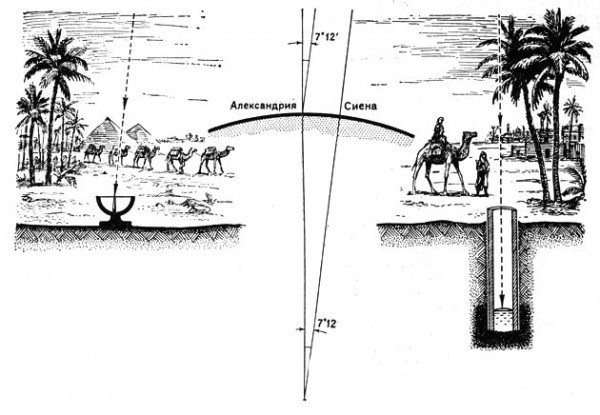
The radius of the Earth was determined by Eratosthenes in 250,000 stages. Unfortunately, we do not know which stages the scientist used, Egyptian or Greek. In the first case, the error with respect to the true size is 1.5%, but even if the radius was obtained in the Greek stages, the result is still impressive - 7080 km (in reality, 6378 km, the error is about 10%).
Predictable chaos
The synthesis of the ancient concept of the structure of the Universe was the classic work “The Mathematical Collection in 13 Books ” by the ancient Greek astronomer Claudius Ptolemy (2nd century AD). Ptolemy's geocentric system was based not only on the philosophy and authority of Aristotle, but also on a solid mathematical apparatus, as well as on the observations of many authoritative ancient astronomers (Hipparchus in particular).
Even in ancient times, people noticed that the planets, the Moon and the Sun move along a certain “corridor” on the celestial sphere, in the region of 13 constellations (12 of which as a result became Zodiac). The one-year path of the Sun along this corridor was called the ecliptic. At the same time, the planets, unlike the Moon and the Sun, do not move evenly, describing circles (backward motion), noticeable in the video below.
Ptolemy's system was a complex mathematical model describing this movement and allowing the ephemeris (the position of the planets) to be calculated for the future with a record accuracy of 10 angles. min (one third of the full disk of the moon). On the basis of his model, the scientist believed that the planets made circular motions along epicycles, the center of which was orbiting (deviant) around the center. And the center was at some distance from the Earth. Although such a system did not look realistic, it did allow to block the errors in calculating the positions of celestial bodies.
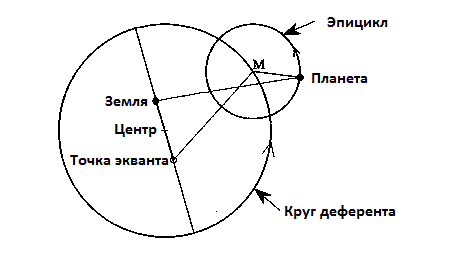
Centuries before the work of Ptolemy, the Greeks were well versed in the dynamics of celestial bodies and even created a kind of primitive computers for calculating ephemeris and eclipses, such as the anti-Hitter mechanism .
Reconstruction of the work of the anti-Hitter computer with the help of the Lego designer
Geocentrism remained the basis of cosmology until the end of the 17th century, refining and becoming more complex throughout all the Middle Ages thanks to the work of intellectuals of the Christian and Muslim world . Ptolemy's works were also actively used for marine navigation at the beginning of the Great Geographical Discoveries.
In "New World" on the path of delusion
In the Middle Ages, as in late antiquity, the version about the sphericity of the Earth dominated, shared, among other things, by most philosophers and theologians. The main discrepancies raised the question of the size of our planet.
Globus Terrae ("Globe") on the geocentric scheme of the early Middle Ages
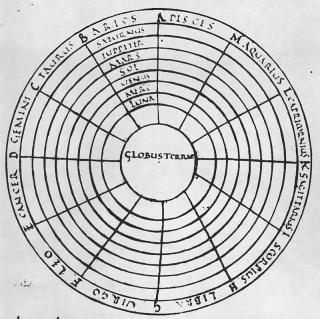
The Italian navigator Christopher Columbus , who entered the service of the Spanish crown, sailed to the west in 1492, believing that the Earth was half the estimates of Eratosthenes, and has a pear-shaped form. The discovery of "India" added weight to the opponents of the Eratosthenes theory, but not for long. The expeditions of another Italian and a friend of Columbus, Amerigo Vespucci, will convince the Europeans that Columbus discovered the New World, and not the way to Asia. Subsequently, for the new part of the world will be fixed the name of a famous researcher - America.
Amerigo Vespucci on the Background of the Map of the Southern Part of the New World

The model of the Earth Eratosthenes will receive experimental confirmation 30 years after the first voyage of Columbus, as a result of the first ever circumnavigation of the Spanish squadron led by the Portuguese Fernand Magellan.
Epoch of the Great Astronomical Discoveries
After experiencing an awareness of the scale of its planet, the attention of the human mind was concentrated on understanding the scale of the universe. In 1543, the Polish astronomer Nicolaus Copernicus completed his 40 year old work “On the Rotation of the Celestial Spheres” , which began the decline of the Ptolemy system of the world and the formation of the heliocentric system. Paradoxically, against the background of the heyday of the Holy Inquisition, the church initially reacted positively to the work of Copernicus. His system was much simpler than Ptolemaic, greatly simplifying the calculations of the position of celestial bodies. It was helped by the fact that one of the friends of Copernicus, against his will, added to the book a note stating that the heliocentric system is a purely mathematical abstraction, not related to reality.
“Copernicus. Conversation with God "(Mud. Mateiko), to the right is a fragment of his work with the scheme of the heliocentric system of the world

Copernicus correctly interpreted the backward movements of the planets by the fact that the Earth, moving in its orbit around the Sun, first caught up with the outer planet (it gradually slowed down on the celestial sphere), and then after the opposition overtook it (the planet stopped and backfired in the opposite direction). At the corners of backward movements, it was possible to determine the relative distances of the planets from the Sun close to modern (Ptolemy, like Aristarchus, believed that the Sun was removed by 20 radii of the lunar orbit). For the first time, Copernicus determined the order of the removal of the planets from the central body, explaining the "unwillingness" of Venus and Mercury to move more than 45 ° from the Sun by the fact that they orbit the Sun inside the Earth orbit.
However, heliocentrism at that time had serious drawbacks. So astronomers complained that the model did not exceed the Ptolemaic in accuracy of calculations. Copernicus believed that the orbits of the planets were perfectly round (had an eccentricity of zero), which eventually led to significant measurement errors. Like Aristarchus, Copernicus was faced with the problem of the absence of a parallax of stars.
Given these shortcomings of the Copernican system, the famous Danish astronomer (more precisely, the astrologer) Tycho Brahe , who lived in the second half of the 16th century, proposed his own version of the planetary system. Basically, it exactly repeated heliocentrism, all the planets revolved around the Sun, but the latter revolved around the Earth, placed in the center of the universe. So Brahe explained the absence of parallax, rejecting the huge emptiness between the planets and the sphere of stars by the criterion of “superfluous essences”, and also satisfied the principles of scholasticism (medieval Christian philosophy with a strong admixture of Aristotelianism).
Brahe geo-heliocentric system

Tycho Brahe has accumulated huge scientific material, having compiled new star catalogs of record accuracy, and for the first time in history has accumulated a solid statistical base for observing the movement of the planets, in particular Mars. For this methodical approach, Brahe was later called the first scientist in history in the modern sense of the word. The paradox of the situation is that Brahe himself was an astrologer (like Ptolemy with Copernicus), and openly said that if it were not for astrology, then there would be no point in astronomy.
Mars, the "apple" of world wideness
Labor Tycho Brahe ironically rendered a great service to heliocentrism. Based on his observations of Mars, the famous German astronomer, astrologer and friend Brahe, Johann Kepler formulated the first laws of planetary motion. The main principles of his work postulated that the speed of the planet decreases with distance from the Sun, and the orbits of the planets are not circular (as Copernicus believed), having an ellipsis shape in one of whose focuses is the Sun (and not in the center). This made it possible to significantly improve the Copernican system, removing from it such rudiments of the Ptolemy system as epicycles (left to parry uneven motion in orbit). The Kepler equation made it possible to calculate the velocity of the planet at any point in the orbit and determine its orbital period. However, Kepler maintained faith in the sphere of stars, arguing that the absence of an infinite universe filled with stars that Edmund Halley would later call a photometric paradox .
Doodle in honor of Johan Kepler's 442th birthday. The scientist is depicted in the center of the Earth's orbit circulating in an elliptical orbit in one of the foci of which the Sun is located. It can be seen that the speed of the planet decreases with increasing distance from the sun. Named in honor of the scientist spacecraft "Kepler" in 2009-2013. discovered more than 1000 exoplanets
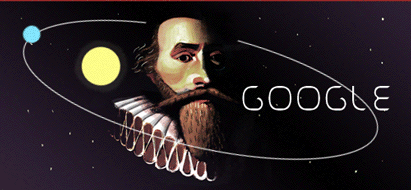
Despite the unpromising accuracy of the Kepler system, in 1616 the Catholic Church forbade its flock to consider heliocentrism as something more than an abstract mathematical model for two centuries. The authorities of the Protestant church also considered "God-making" heliocentrism. It should be remembered that the rapid flourishing of science in Europe in the first half of the 17th century was combined with destructive religious wars and a loud religious trial of a prominent scientist.
A contemporary of Kepler, the Italian scientist Galileo Galilei , first sent a telescope to the sky (1609), denied Aristotle’s cosmology, showing that the “celestial spheres” are not perfect at all, spots were visible on the Sun, and there were craters and mountain ranges on the Moon. In addition, he discovered in Jupiter 4 moons (1610g) that the empirical refuted the thesis of Aristotle that all celestial bodies revolve around the Earth. For the support of heliocentrism, Galileo will appear before the Inquisition in 1633.
Galileo before the Inquisition (art. Cristiano Banti)
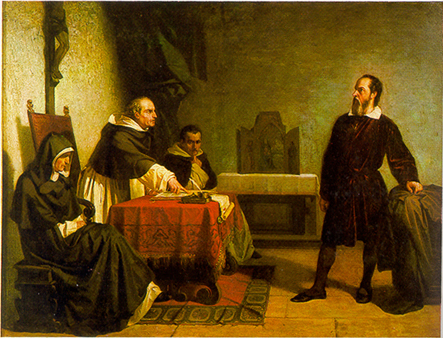
However, this will not stop scientific thought. Thanks to Kepler's laws and the telescope invented, the heliocentric system will make tremendous progress throughout the 17th century. The exact relative positions of the planetary orbits in the solar system were obtained, the radius of the earth orbit (astronomical unit) was taken as the unit of distance. The accuracy of Kepler's celestial mechanics was such that by determining the absolute distance between any two bodies of the solar system, it was possible to determine all other distances and realize the absolute dimensions of the solar system (then the most distant planet was Saturn).
This again helped solid statistics observations of Mars. In 1672, during the reign of the Sun King (Louis 14th), the French astronomers Cassini and Richet managed to determine the parallax of Mars against distant stars, first calculating the absolute distance to it. Due to this, Cassini with a fairly high accuracy determined the value of the astronomical unit - 146 million km (the current value - 149 million km). After 3 years, in 1675, the Danish astronomer Remer, who worked together with Cassini in Paris, discovered a delay in the calculations for the motion of the satellites of Jupiter and determined the finite velocity of light with an error of 30% (1676g).
The parallax scheme of Mars . Two viewpoints were removed on the surface of the Earth (Cassini in Paris and Richet in Cayenne, South America). At one point in time, the position of Mars relative to the stars at these points was different, which allowed scientists to calculate the distance to the planet
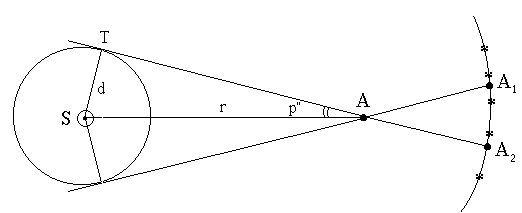
In 1687, relying on Kepler's celestial mechanics, the genius of Isaac Newton would formulate the laws of universal perception, which further increased the accuracy of celestial mechanics and described gravitational interactions in the solar system. Thus, astronomical observations also led to a revolution in applied science. The astronomical unit will be refined up to the era of radar measurements in the 20th century. In the 18th and 19th centuries, the Venus parallax will be used for this during its passage through the solar disk. During one of these passages, Lomonosov will open the atmosphere of the planet in 1761.
In 1727, the English astronomer Bradley, in search of the parallax of stars, indeed discovers a change in their position on the celestial sphere with the one-year motion of the Earth. However, this change was not similar to parallax, and Bradley correctly interpreted the phenomenon of aberration — a change in the direction of the speed of the Earth relative to the light of a star. So Bradley confirmed the finite speed of light (at the level of 300 000 km / s) and the empirical proved the orbital motion of the Earth around the sun.
A similar program to search for stellar parallax in 1781 will lead the English astronomer Herschel to the discovery of the planet Uranus. The real triumph of celestial mechanics will be the discovery of Neptune "at the tip of the pen" in 1846 by the English astronomer Adams and his French counterpart Le Verrier.
The parameters of the orbit of Uranus indirectly confirmed the then-popular Titius-Bode rule among scientists, a simple arithmetic regularity of the distance of planets from the Sun. So the search for the missing planet between the orbits of Mars and Jupiter led in the early 19th century to the discovery of the asteroid belt. However, the discovery of Neptune refuted this mathematical oddity, and the total mass of the “destroyed Phaeton” asteroids did not exceed 5% of the Moon’s mass.
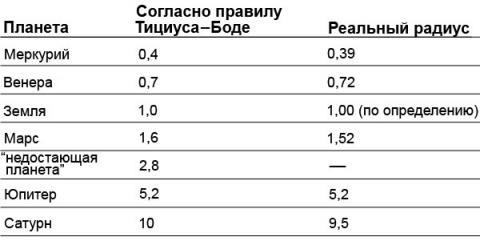
The holistic picture of the mechanics of the planets of the solar system will be completed only in the 20th century with the help of Einstein's theory of relativity, which successfully explained the anomalies of Mercury's orbit. However, already in the 18th century, there began a “hunt for stellar parallax”, an attempt by the human mind to breach the “sphere of stars” and enter the interstellar spaces.
In the second part of the chronicle of comprehension of the scale of our world, I will tell you a truly detective story about the definition of interstellar distances by a person and beyond - to the edges of the visible Universe.
Source: https://habr.com/ru/post/372571/
All Articles